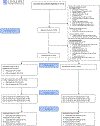Promoting Cognitive Stimulation in Parents Across Infancy and Toddlerhood: A Randomized Clinical Trial
- PMID: 36481243
- PMCID: PMC10121799
- DOI: 10.1016/j.jpeds.2022.11.013
Promoting Cognitive Stimulation in Parents Across Infancy and Toddlerhood: A Randomized Clinical Trial
Abstract
Objective: To test the impact of the fully integrated Smart Beginnings model on parental support of cognitive stimulation from 6 to 24 months across infancy and toddlerhood.
Study design: This was a single-blind, 2-site randomized clinical trial of the Smart Beginnings intervention. Enrollment took place at birth in postpartum units of hospitals in New York City and Pittsburgh, Pennsylvania, with a consecutive sample of 403 mother-infant dyads. Smart Beginnings combines a Video Interaction Project-14-session universal primary prevention program delivered in the pediatric clinic at the time of well-child visits birth-36 months-with potential for Family Check-Up-3-4 sessions targeted secondary prevention home-visiting program. The principal outcome was parental support of cognitive stimulation assessed via parent survey and video-recorded observations of parent-child interactions. Ordinary least squares and mixed effects regressions were conducted.
Results: Families were mostly Black/African-American (50%) or Latinx (42%); all were Medicaid eligible (100%). Smart Beginnings significantly promoted cognitive stimulation during infancy and toddlerhood for most survey outcomes across time, including StimQ common total (effect size [ES] = 0.25, P = .01) and READ Quantity (ES = .19, P = .04) and Quality (ES = .30, P = .001). For the observations, the impact of Smart Beginnings varied by time, with significant impacts at 6 (ES = 0.37-.40, P < .001) and 24 (ES = 0.27-.30, P < .001) months, but not 18 months.
Conclusions: Smart Beginnings positively promotes cognitive stimulation from infancy through toddlerhood using the integrated model. This study adds to the body of research showing preventive interventions in pediatric primary care and home visiting can support early relational health including parental support of cognitive stimulation.
Trial registration: NCT02459327.
Copyright © 2022 Elsevier Inc. All rights reserved.
Figures




References
-
- Dreyer BP. Closing the Gap: Interventions to Ameliorate Inequities in Early Brain Development and School Performance in Poor Children. J Pediatr. 2020;221:8–10. - PubMed
-
- Raikes H, Alexander Pan B, Luze G, Tamis-LeMonda CS, Brooks-Gunn J, Constantine J, et al. Mother–child bookreading in low-income families: Correlates and outcomes during the first three years of life. Child Dev. 2006;77:924–53. - PubMed
-
- Duncan GJ, Dowsett CJ, Claessens A, Magnuson K, Huston AC, Klebanov P, et al. School readiness and later achievement. Dev Psychol. 2007;43:1428–1428. - PubMed
-
- Duncan GJ, Ziol-Guest KM, Kalil A. Early-childhood poverty and adult attainment, behavior, and health. Child Dev. 2010;81:306–25. - PubMed

